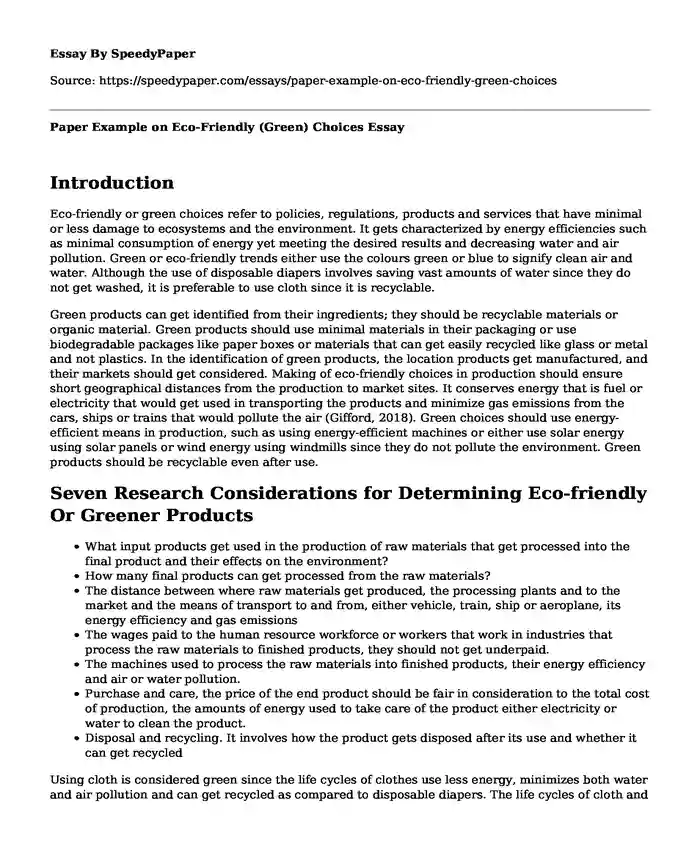
| Type of paper: | Creative writing |
| Categories: | Policy Ecology Organizational culture |
| Pages: | 3 |
| Wordcount: | 746 words |
Introduction
Eco-friendly or green choices refer to policies, regulations, products and services that have minimal or less damage to ecosystems and the environment. It gets characterized by energy efficiencies such as minimal consumption of energy yet meeting the desired results and decreasing water and air pollution. Green or eco-friendly trends either use the colours green or blue to signify clean air and water. Although the use of disposable diapers involves saving vast amounts of water since they do not get washed, it is preferable to use cloth since it is recyclable.
Green products can get identified from their ingredients; they should be recyclable materials or organic material. Green products should use minimal materials in their packaging or use biodegradable packages like paper boxes or materials that can get easily recycled like glass or metal and not plastics. In the identification of green products, the location products get manufactured, and their markets should get considered. Making of eco-friendly choices in production should ensure short geographical distances from the production to market sites. It conserves energy that is fuel or electricity that would get used in transporting the products and minimize gas emissions from the cars, ships or trains that would pollute the air (Gifford, 2018). Green choices should use energy-efficient means in production, such as using energy-efficient machines or either use solar energy using solar panels or wind energy using windmills since they do not pollute the environment. Green products should be recyclable even after use.
Seven Research Considerations for Determining Eco-friendly Or Greener Products
- What input products get used in the production of raw materials that get processed into the final product and their effects on the environment?
- How many final products can get processed from the raw materials?
- The distance between where raw materials get produced, the processing plants and to the market and the means of transport to and from, either vehicle, train, ship or aeroplane, its energy efficiency and gas emissions
- The wages paid to the human resource workforce or workers that work in industries that process the raw materials to finished products, they should not get underpaid.
- The machines used to process the raw materials into finished products, their energy efficiency and air or water pollution.
- Purchase and care, the price of the end product should be fair in consideration to the total cost of production, the amounts of energy used to take care of the product either electricity or water to clean the product.
- Disposal and recycling. It involves how the product gets disposed after its use and whether it can get recycled
Using cloth is considered green since the life cycles of clothes use less energy, minimizes both water and air pollution and can get recycled as compared to disposable diapers. The life cycles of cloth and disposable diapers are productions, use and disposal or recycling stage. The raw material production stage for both involves the production of cotton which consists of the use of pesticide although for disposable diapers it involves manufacturing of polythene paper that is used to make the diaper lining and emits hazardous gasses into the air (Horner,2015). The polythene paper is non-biodegradable, pollutes land when disposed of in landfills and water when disposed into oceans or rivers since they take long to disintegrate. The production of disposable diapers engages an extra cost since it involves transport of the polythene lining to the diaper factory. It results in more gas emissions and energy consumptions by the modes of transportation, whereas the cloth only incurred one cost of transporting the cotton and finished product. The use of cloth involves use of more water and energy and electricity in washing and drying the cloth, although it's incomparable to detrimental effects of the disposable diapers to water, ocean life and air pollution. Cloth save energy and resources since they can get washed, dried and used again while disposable diapers only get used ones.
Conclusion
In conclusion, Eco-friendly or green choices involve products and services that have minimal or less damage to ecosystems and the environment. Cloth should get used compared to disposable diapers. Cloth saves energy resources and minimizes water and air pollution. Educational programs should encourage people to use cloth in comparison with disposable diapers.
Works Cited
Horner, C. The life cycle of a t-shirt .2015 March 7. Retrieved from https://www.youtube.com/watch? v=5Ckgw5xvZV4. Accessed on 2019 November, 11.
Gifford, D. Why disposable diapers are dirty and dangerous 2018 May, 24. Retrieved from https://www.smallfootprintfamily.com/dangers-of-disposable-diapers.Accessed on 2019 November, 1,
Cite this page
Paper Example on Eco-Friendly (Green) Choices. (2023, Mar 07). Retrieved from https://speedypaper.com/essays/paper-example-on-eco-friendly-green-choices
Request Removal
If you are the original author of this essay and no longer wish to have it published on the SpeedyPaper website, please click below to request its removal:
- Free Essay about History of Gun Control in America
- Essay Sample on Physiological Adaptations after Two Weeks Training in Heat
- Free Essay Sample on Multinational Corporations
- Free Essay Dedicated to Globalization
- Ethical Issues with an Aging Population, Essay Example
- America's Shame by Peter Singer - Essay Example with the Article Review
- Law Essay Example: The Code of Hammurabi
Popular categories




